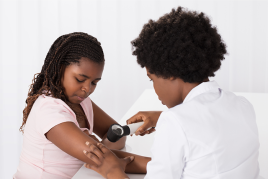Ichthyosis vulgaris: Who gets and causes
Who gets ichthyosis vulgaris?
To get ichthyosis vulgaris, one of the following must happen. The person can:
Inherit genes for ichthyosis from one or both parents
Develop a gene mutation for ichthyosis while in the womb
Get a disease or take a medicine that can trigger ichthyosis
When caused by genes, the disease appears during childhood, usually between 3 months and 5 years of age. This type of ichthyosis vulgaris is called inherited ichthyosis vulgaris. It often runs in families.
The other type of ichthyosis vulgaris is very rare. Called acquired ichthyosis vulgaris, this type usually affects adults only. It appears when it is triggered by a disease or medicine.
People of all races get ichthyosis vulgaris. About the same number of males and females develop this disease.
What causes ichthyosis vulgaris?
Inherited ichthyosis vulgaris is caused by genes. The person either inherits the genes for this disease from one or both parents or genes changes while the baby is forming inside the womb. As a result, the skin has less filaggrin than it needs. The body needs filaggrin to create a healthy outermost layer of skin.
Without enough filaggrin, the body cannot shed skin cells as it should. The older skin cells build up on the skin’s surface, causing the scale and thickened skin.
Acquired ichthyosis vulgaris has a different cause. A disease usually triggers it. Diseases that can trigger it include long-term kidney failure, different types of cancer (especially lymphoma), sarcoidosis, and infections such as leprosy and HIV.
Acquired ichthyosis vulgaris can show up before the person has signs of the triggering disease. If this happens, the person should have a complete physical. It’s important to find the cause.
In very rare cases, a medicine or vitamin can trigger acquired ichthyosis vulgaris. Ones that can do this, include:
Cimetidine (an antacid and antihistamine used to treat ulcers and acid reflux)
Clofazimine (a drug used to treat leprosy)
Nicotinic acid, a B vitamin
References
James WD, Berger TG, et al. “Genodermatoses and congenital anomalies.” In: James WD, Berger TG, et al. Andrews' Diseases of the Skin, Clinical Dermatology (tenth edition), Elsevier, Canada, 2006:560-1.
Richard G and Ringpfeil F. “Ichthyoses, erythrokeratodermas, and related disorders.” In: Bolognia JL, et al. Dermatology. (second edition). Mosby Elsevier, Spain, 2008:743-9.
Schwartz RA. “Hereditary and acquired ichthyosis vulgaris.” In: Elston DM, (chief editor) Medscape. Last updated June 22, 2016.
 Molluscum contagiosum: How to safely treat it
Molluscum contagiosum: How to safely treat it
 Biosimilars: 14 FAQs
Biosimilars: 14 FAQs
 Practice Safe Sun
Practice Safe Sun
 Relieve uncontrollably itchy skin
Relieve uncontrollably itchy skin
 Fade dark spots
Fade dark spots
 Untreatable razor bumps or acne?
Untreatable razor bumps or acne?
 Laser hair removal
Laser hair removal
 Scar treatment
Scar treatment
 Botox
Botox
 Free materials to help raise skin cancer awareness
Free materials to help raise skin cancer awareness
 Dermatologist-approved lesson plans, activities you can use
Dermatologist-approved lesson plans, activities you can use
 Find a Dermatologist
Find a Dermatologist
 What is a dermatologist?
What is a dermatologist?